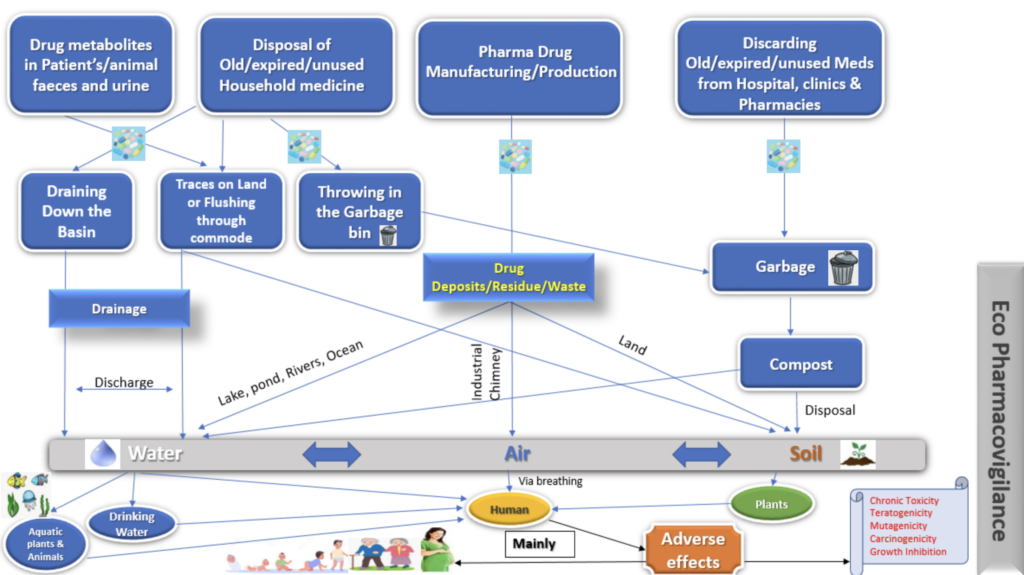
×

The pace at which medical science is advancing is remarkable. Drug manufacturing and the use of prescription medications continue to rise dramatically around the world. At the same time, the overall volume of drug waste is growing substantially, posing a significant health and environmental risk. The proper management, disposal, and recycling of expired and unused medicines—known as pharmaceutical pollutants (PhP)— to reduce environmental contamination remains a challenge. Amid severe pharmaceutical pollution, ecopharmacovigilance (EPV) has sparked sudden attention. EPV is a term that refers to the surveillance of possible impacts of PhPs on the environment. The primary purpose is to make sure that serious risks/hazards linked to pharmaceutical medicines encountering the natural environment are recognized and dealt with as quickly as possible.

The Effects of PhPs on the Environment
Most of the prescription pills humans or animals take are poorly absorbed and metabolized by the body that is emitted through excretion as residue/metabolites that directly interacts with the surroundings, predominantly through air/soil/water. Furthermore, the careless disposal of old, outdated, or unused pharmaceutical medicines anywhere other than a proper receptacle—roadsides, lakes, ponds, rivers, beaches, etc.—plays a major role in exposing drugs into the ecosystem. Because of the potential harmful/toxic effects, pharmaceutical drugs are classified as emerging contaminants that can affect animals, humans, and the ecosystem.
PhPs have been found in the environment at relatively low concentrations (Nanogram/L to Microgram/L), which can transform into harmful toxic substances and pose possible threats to humans. In the case of specific groups like pregnant women, kids, and elderly people, it can possibly cause serious life-threatening adverse effects such as child growth inhibition, chronic toxicity, teratogenicity, mutagenicity, cancer, and more. Thus, pharmaceutical contamination levels must be closely monitored.
Why EPV is Important
The idea of being “environmentally conscious” is growing among individuals, organizations, and the government. This is evident is the U.S. Administrations’ Health Sector Climate Pledge to reduce greenhouse gas emissions 50% by 2030, reaching net-zero emissions by 2050. New pledges from within the health care industry show the commitment by leaders to protect public health, improve costs, and to fight against the effects of climate change.
Healthcare is meant to improve the quality of life and help people to get “healthy.” Unfortunately, the way medicines, supplies, and equipment are made and are moved through the supply chain, can, in fact, cause people to become sick, undermining the goal of health care. The healthcare sector accounts for 8.5% of U.S. greenhouse gas emissions. These emissions are responsible for increasing air pollution and affecting climate change, adding to extreme weather, supply chain disruptions, and chance of wildfires.
Furthermore, in the way of pollution, pharmaceuticals find their way into the environment in three main ways: waste from production, unused medicines that are improperly disposed of, and patient use. All of these pose danger to humans, animals, and aquatic life. In Europe, 2% of pharmaceuticals enter the environment through production, 10% from unused medicines, and 88% through patient use. However, through vigilance, research, and conducting environmental risk assessments, pharmaceutical companies are committed to understanding the risks of pharmaceuticals in the environment.
Putting Ecopharmacovigilance into Practice
For EPV to be effective, it must be addressed at many levels inside and outside the healthcare industry. Below are the areas in which it must be adopted to help reduce ecological drug contaminations:
The Future of EPV
Nowadays, pharmaceuticals are receiving more attention from pharmacovigilance professionals, environmental scientists, and global health regulatory authorities after being identified as one of the key drug pollutants. Ecopharmacovigilance is a practical and effective strategy to mitigate the risks posed by environmental drug residues. It is an exciting and emerging field that is slowly gaining traction. It will be crucial to watch future developments in this sector to determine opportunities and challenges.
The Apexon sustainability framework helps speed up transformation of the net zero journey as soon as you have defined your strategy and ambitions for a sustainable future. Our transformational approach across the IT value chain not only focuses on the internal IT but also enterprise and customer operations. Apexon provides you with utmost transparency to sustainability goals by leveraging reliable data. We embrace AI to power sustainable actions. Our 5-step approach helps businesses embed sustainability data and performance into everything they do to effectively measure the business value and sustainable impact for all stakeholders.
To learn more about Apexon’s sustainability analytics framework, get in touch using the form below.